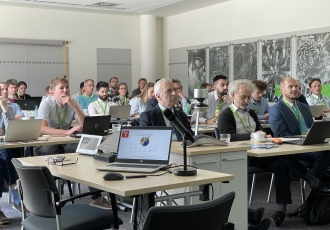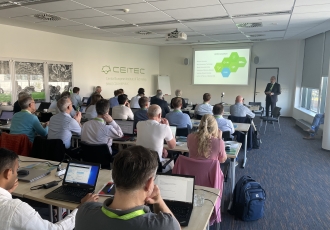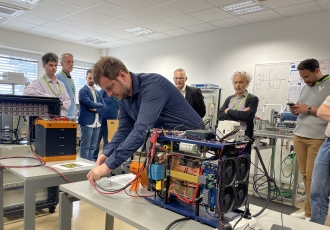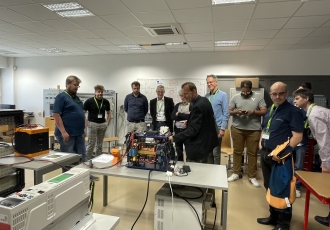26. June 2024
A total of 33 partners from 7 European countries. Industrial companies, universities and research institutions. From the automotive industry to agricultural technology to renewable energies. The TRANSFORM project, which also involves the research team from CEITEC BUT and FEEC BUT, has it all. CEITEC BUT also hosted the General Assembly meeting of this project on 15 and 16 May 2024 and successfully presented a demonstrator of a remote-controlled battery-powered charger for excavators (mechanical diggers).
The European project “Trusted European SiC Value Chain for a Greener Economy”, TRANSFORM for short, aims to build a resilient European supply chain for power electronics based on silicon carbide (SiC) technology. This is to be achieved through the collaboration of 33 partners from 7 European countries, including industrial companies, universities and research institutions. One of the partners of the project is Brno University of Technology, represented by researchers from CEITEC BUT and the Department of Power Electrical and Electronic Engineering (DPEEE) of the Faculty of Electrical Engineering and Communication (FEEC) BUT.
And what makes SiC-based technology so special? “Power silicon components, whose operating frequencies are relatively limited, are commonly used for switching power converters. Therefore, new SiC-based materials have been developed by introducing a carbon atom into high-purity silicon's crystal structure, giving the material special physical properties. These semiconductor materials are able to operate at higher voltage and current loads with higher switching frequencies. They also have exceptional thermal and electrical properties,” explains Radimír Vrba, head of research and development at one of the demonstrators. Among the key parameters of silicon carbide, he cites in particular: low thermal resistance, higher breakdown voltage, higher current density, lower on-state voltage drop, lower power dissipation at the on-state switch, the ability to operate at temperatures up to 600 °C, and shorter on and off times.
“Thus, due to their speed, silicon carbide components enable higher switching frequency compared to pure silicon chips without increasing their so-called switching losses. The higher switching frequency makes it possible to reduce the size of the transformers and inductors used in the devices in which these semiconductors are used (e.g. electric vehicle chargers). Due to the lower resistance in the switched state, the losses caused by the current conduction are also lower. Reducing switching and conduction losses together contributes to increasing energy use efficiency,” adds Pavel Vorel from DPEEE at FEEC BUT.
The new SiC-based MOSFET power switches will find application practically everywhere where higher powers are used. Typical applications include power converters, fast chargers, drive units for industrial machinery, electric vehicles and power converters for photovoltaic power plants. As Metin Koyuncu of BOSCH, coordinator of the TRANSFORM project, says: “SiC is a critical material technology that addresses the limitations of conventional Si semiconductor material and plays a key role in the development of electrification in important industries. Our technological advances in advanced SiC wafers, SiC MOSFET device technology, processing including processing equipment and power modules with innovative assembly and interconnect technologies are strengthening Europe’s market position.” His role, i.e., the coordinator's role, is to manage the TRANSFORM consortium to achieve technology goals set at the start of the project. Focusing on the entire value chain requires interdisciplinary cooperation between many experts working on many R&D topics. Dividing the project into work packages, ensuring effective collaboration within the consortium and representing the consortium to public authorities in Brussels are all among his key responsibilities.
The TRANSFORM project brings partners together to work and demonstrate applications of SiC-based components in 5 demonstrators in the automotive, agriculture, manufacturing and renewable energy sectors. As the coordinator Koyuncu says: “BUT is responsible for one of these demonstrators and they are showing excellent results. Its work improves the quality of life and is also in line with the European Green Deal, helping Europe to achieve its goal of becoming the first climate-neutral continent.”
The research team from CEITEC BUT with colleagues from DPEEE FEEC BUT and in cooperation with another Czech partner, company IMA, addressed the case of a demonstrator for a specific application of advanced SiC-based components in the design and implementation of an industrial single-stage three-phase AC/DC converter for use as a charger for battery-powered industrial tools and machines. The high switching frequency of the inverter with a pulse transformer made it possible to reduce the weight and size of the transformer. By using very fast SiC components, we reduced the high switching losses and achieved high efficiency of the charger. The high switching frequencies also allowed for the use of a smaller transformer, which then reduced the weight and size of the inverter. The development of the demonstrator was completed with its successful implementation,” Radimír Vrba sums up with satisfaction. “The set parameters have been achieved; moreover, the extended remote control and data collection with cloud storage have increased the charger’s utility properties beyond the original requirements," explains Jaroslav Kadlec from CEITEC BUT.
The project was originally scheduled to end at the end of April 2024, but certain problems with the delivery of experimental components necessitated a postponement of the final project completion date to the end of October 2024. According to the interim checks and the presentation at the May General Assembly meeting in Brno, it appears that all defined tasks and work packages of the TRANSFORM project will be completed by this new deadline.
The TRANSFORM General Assembly in Brno on 15 and 16 May 2024 was evaluated by all participants as a great success. Many complimentary remarks were made about the organization, the presentations given by CEITEC BUT and subsequently by the BUT Rector Ladislav Janíček, the tour of the cleanroom laboratories of CEITEC Nano research infrastructure and the laboratories of the Department of Power Electrical and Electronic Engineering and the Department of Microelectronics at FEEC BUT. Many of the partners were pleasantly surprised by the size of the BUT, its importance, professional focus, the number of students, including foreign students, and the developed cooperation with industry and research partners. “The TRANSFORM consortium has worked very well together, and we have achieved many interesting results, as also evidenced by the huge number of publications we have produced,” Metin Koyuncu concludes with appreciation.


 Share
Share





